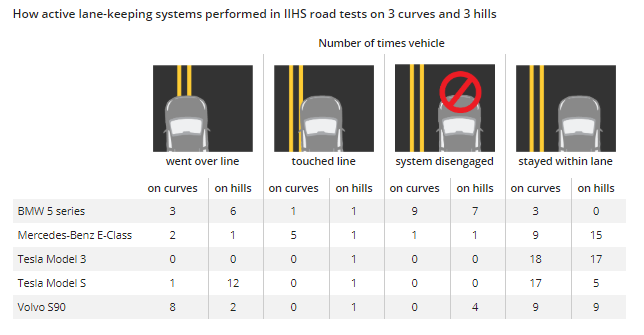Insurance Institute for Highway Safety research shows that preventing lane-departure crashes could save nearly 8,000 lives in a typical year (see “New estimates of benefits of crash avoidance features on passenger vehicles,” May 20, 2010). However recent tests show that only one system was effective at keeping the vehicle between the lane lines.
Active lane-keeping
Engineers focused on two situations that challenge active lane-keeping systems — curves and hills — in tests on open roads with no other vehicles around. They also observed how the systems performed in traffic.
All five systems provide steering assistance that centers the vehicle within clearly marked lanes. They also may use a lead vehicle as a guide when traveling at lower speeds or when the lead vehicle is blocking the system’s view of the lane markers ahead.
To test active lane-keeping on curves, engineers conducted six trials with each vehicle on three different sections of road with radii ranging from 1,300 to 2,000 feet.
Only the Model 3 stayed within the lane on all 18 trials. The Model S was similar but over corrected on one curve, causing it to cross the line on the inside of the curve in one trial. None of the other systems tested provided enough steering input on their own to consistently stay in their lane, often requiring the driver to provide additional steering to successfully navigate the curve.
The E-Class stayed within the lane in 9 of 17 runs and strayed to the lane marker in five trials. The system disengaged itself in one trial and crossed the line in two. The 5 series stayed within the lane in 3 of 16 trials and was more likely to disengage than steer outside the lane. The S90 stayed in the lane in 9 of 17 runs and crossed the lane line in eight runs.
When trying out new vehicles in hilly Central Virginia, home to the Vehicle Research Center, engineers noted early on that advanced driver assistance systems that rely on seeing road markings to keep vehicles in their lanes were sometimes flummoxed by hills. As a vehicle crests a hill, the lane markers on the road beyond are obscured.
For the on-road tests, engineers mapped out a course that included three hills with different slopes. Drivers made six trial runs on each hill in each vehicle.
The E-Class stayed in its lane in 15 of 18 trials and on the line in one trial, continuously providing steering support without erratic moves when lane lines weren’t visible. The Model 3 also stayed in the lane in all but one trial, when it hugged the line.
In contrast, the 5-series, Model S and S90 struggled. The 5-series steered toward or across the lane line regularly, requiring drivers to override the steering support to get it back on track. Sometimes the car disengaged steering assistance on its own. The car failed to stay in the lane on all 14 valid trials.
The Model S was errant in the hill tests, staying in the lane in 5 of 18 trials. When cresting hills, the Model S swerved left and right until it determined the correct place in the lane, jolting test drivers. It rarely warned them to take over as it hunted for the lane center. The car regularly veered into the adjacent lanes or onto the shoulder.
When drivers intervened to avoid potential trouble, the active lane-keeping system disengaged. Steering assistance only resumed after drivers re-engaged Autopilot.
The S90 stayed in the lane in 9 of 16 trials. The car crossed the lane line in two trials and in four trials disengaged steering assistance when it crested hills but automatically re-engaged when the system once again detected the markings.
One issue drivers noted among some of the vehicles was a propensity to follow a lead vehicle into the exit lane in slow-moving traffic, even though the driver intended to stay the course. When a car is traveling too slow to track lane lines, active lane-keeping systems use the vehicle in front as a guide. If the lead vehicle exits, the trailing car might, too.
The evidence for safety benefits of active lane-keeping systems isn’t as pronounced as for ACC. Still, the potential to prevent crashes and save lives is large. IIHS research shows that preventing lane-departure crashes could save nearly 8,000 lives in a typical year (see “New estimates of benefits of crash avoidance features on passenger vehicles,” May 20, 2010). Lane-departure warning systems are associated with an 11 percent reduction in the rates of single-vehicle, sideswipe and head-on crashes of all severities and a 21 percent reduction in the rates of injury crashes of the same types (see “Stay within the lines: Lane departure warning, blind spot detection help drivers avoid trouble,” Aug. 23, 2017).

